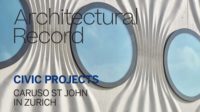Record Houses 2009
Villa 1 ![]() Vienna Way Residence
Vienna Way Residence ![]() House for a Photographer II
House for a Photographer II ![]() Dutchess County Guest House
Dutchess County Guest House ![]() Brick-Weave House
Brick-Weave House ![]() Upstate New York House
Upstate New York House ![]() N House
N House ![]() YTL Residence
YTL Residence ![]() Desert City House
Desert City House![]() House Ijburg
House Ijburg![]() House in Carapicuiba
House in Carapicuiba![]() House in Garrison
House in Garrison![]() House on TownLine Road
House on TownLine Road ![]() Pencalenick House
Pencalenick House ![]() Ventana Canyon House
Ventana Canyon House
Upstate New York
As you approach Thomas Phifer and Partners’ house in upstate New York, the long, steep climb up a winding country road ends not with a dramatic structure, nor a sweeping panorama; its denouement is merely a prelude to the multifaceted spatial sequence to come. Everything about this rural retreat—whose design and construction has spanned a decade—is deliberate and unhurried, a jarring contrast to the frenzied lifestyle of the Manhattan-based family that escapes here on weekends.
Phifer, AIA, also based in Manhattan, is very familiar with this region of New York. Since work began on this residence, his firm completed two other houses in the area. But this last one most fully engages its natural surroundings. According to the architect, “The design is all about a choreography on the site.” Phifer was inspired by the simple way nearby Shaker houses frame views, and by the Classical grandeur of Monticello, Thomas Jefferson’s hilltop estate in Virginia, but the most striking reference is to a more recent landmark—Louis Kahn’s Salk Institute in La Jolla, California (1959–65).
Taking his cue from the Salk, Phifer arranges two objects, or series of objects, on opposite sides of a level, grassy courtyard, creating perspectival views of the Hudson River Valley beyond. On one side sits a tall glass pavilion containing the public areas of the house. Its freestanding presence on the promontory is both majestic and ephemeral when contrasted with the insular bedroom cabins across from it, embedded into the hillside much like the Franciscan monastic complex in Assisi, Italy, that inspired Kahn’s masterpiece.
Situated atop the highest ridge of the rolling, 200-acre property, this arrangement is only one of many moves in Phifer’s well-orchestrated dance. Before arriving at that courtyard, which serves as a green roof to the house’s lower level, a smaller entry court, or car park, greets visitors slightly downhill. Floating above its graveled surface is the cantilevered yoga studio-cum-bedroom (via a Murphy bed) of the guest house. Set back in the original design, the cantilever is not an aggressive one. Instead, the room is gently perched upon a low, north-south running wall, affording incredible views of the meadow to the east and pine forest beyond, and creating an idyllic spot for practicing yoga, an integral part of the family’s quiet weekend getaways.
The wall acts as a spine that bisects the site and fixes the architectural elements to it. Its deep red patina is a product of the weathering steel that clads it, a material Phifer says “comes from the land,” and one that is, from a distance, indistinguishable from the mahogany that covers the steel frame of the glazed surfaces, and the solid walls of the bedroom cabins that protrude from the earth to face the pavilion. The tall, glass walls of the cabins, four in total, face east to views of the meadow, allowing the morning sun to bathe the sleeping quarters.
Between each of the bedroom cabins is a bathroom that opens out to an individual bamboo garden. The repetitive succession culminates at one end with the large master bedroom suite, and at the other with a family room, the cozy main space of the lower level, where office, laundry, and storage space is also located. The continuous wall of the long corridor between is covered with photographs belonging to the family’s vast art collection, which includes large sculptural pieces scattered throughout the property.
Inside the glazed pavilion itself are the kitchen, living room, and dining room. The simple interior palette is dominated by rich, mahogany floors. But here more than anywhere the focus is outside. The 151⁄2-foot-tall glass walls feature slender steel columns, bolstered by diagonal bracing within the upper half, where fixed, horizontal louvers block the sun’s glare along the east and west elevations. At eye level, views are unimpeded. To the south and west the earth drops off, allowing sweeping vistas of the valley. To the north, an allée of London plane trees draws the eye to a trellised outdoor dining area just behind the guest house. Less formal outdoor gathering spots include a terrace under the pavilion’s large, south-facing overhang.
Emerging from that winding road, the experience of the house unfolds gradually like a slow, ordered path of discovery—for city dwellers, a peaceful walk in the woods.
















Post a comment to this article
Report Abusive Comment